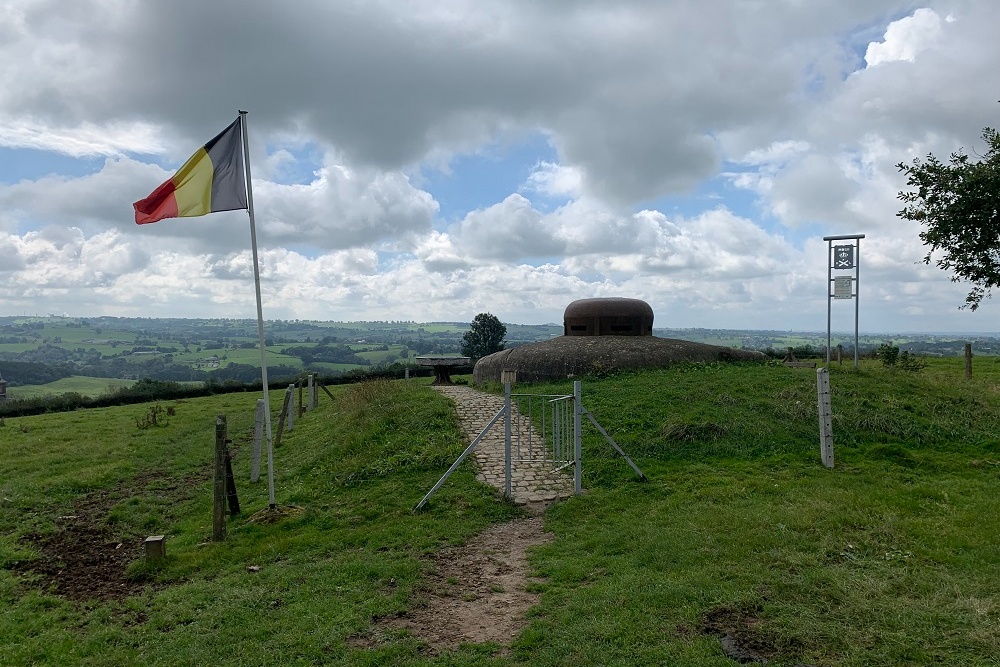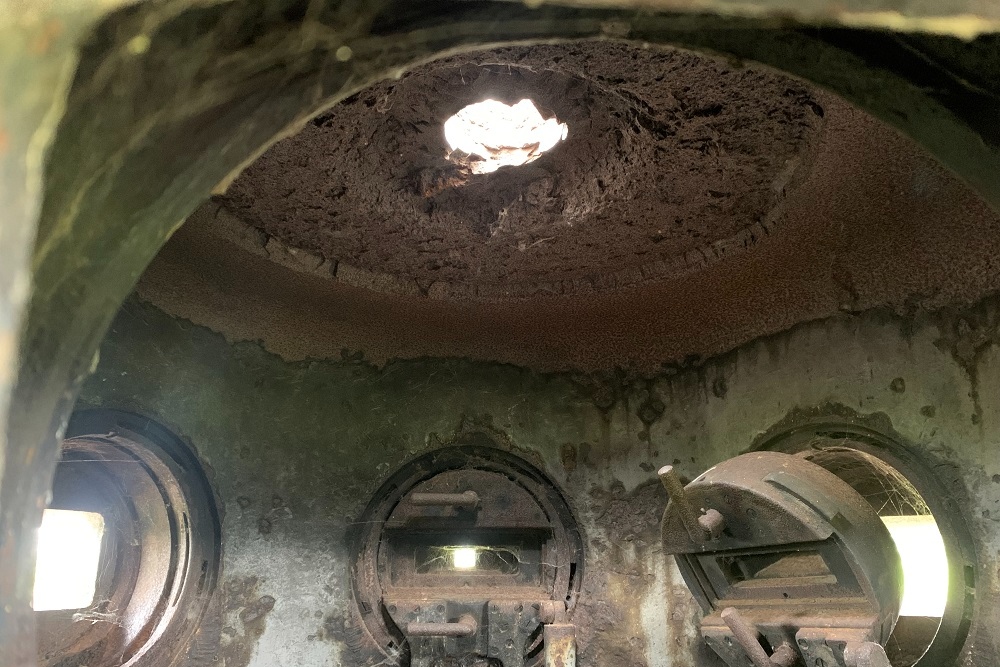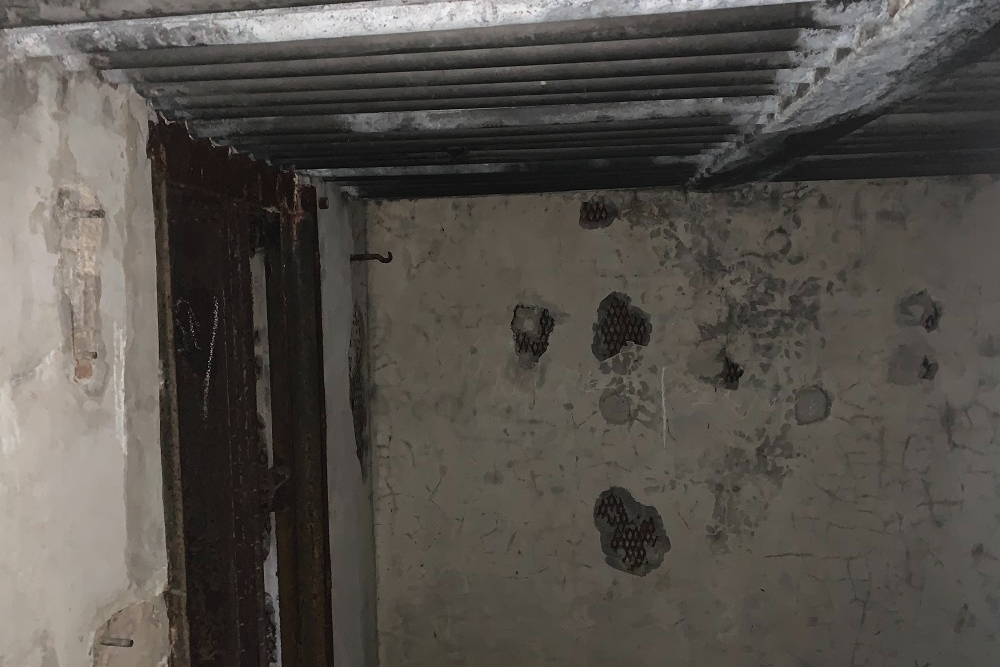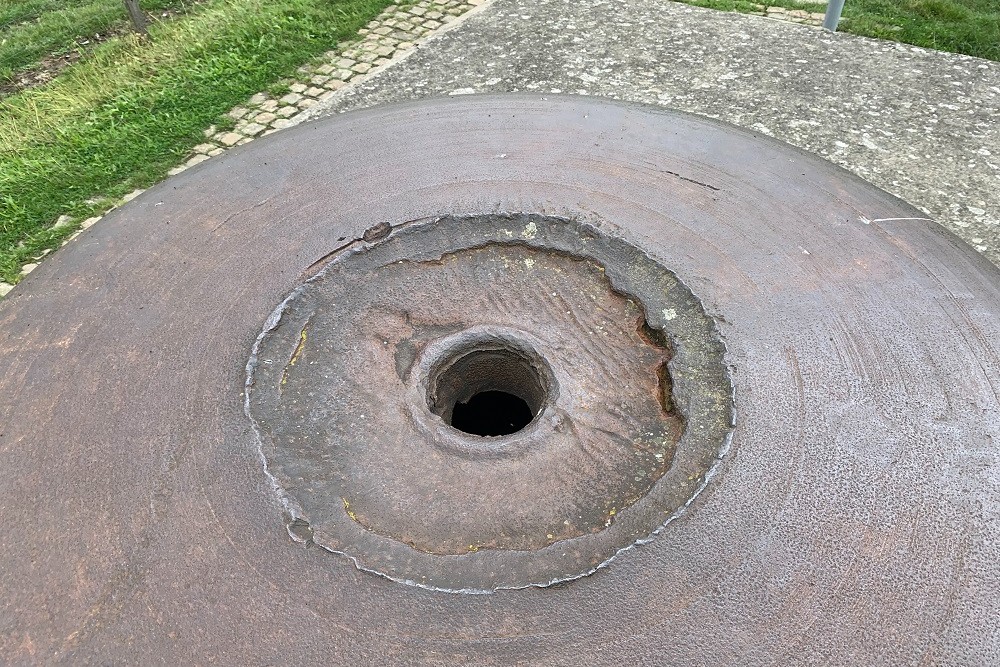Observation Bunker MN18
This is observation bunker MN 18.
The bunker belongs to 1st defense line of 'La Position Fortifiée de Liège', the PFL 1. Specifically, the bunker belongs to the sector 'Margarins-Neufchâteau' of which it is the 18th bunker. This sector consisted of a total of 31 bunkers.
The dome is of the type FM. To be recognized by its tapered shape in contrast to the cupola of the type Guet, which has a straight shape.
As with bunker MN29 the turret was damaged by the use of a 50 kg hollow charge. This was attached on top of the turret, at the point where the periscope was located. Although the force of the charge did not destroy the turret, it was severely damaged and put out of action. The bundled downward heat of nearly 3,000 degrees Celcius. and the force released destroyed everything on its way down. On the inside you can even see the imprint that the hollow charge produced. The force shattered metal shards from the inside of the turret.
At the time of the German invasion on May 10th, 1940, bunker MN18, was passed by a German the bunker, came under fire. The bunker withstood the attack with ease. Later that day, the crew of the observation bunker notices that the Germans are deploying an artillery battary at a nearby crossroad. They immediately transmit the coordinates to the fort and request fire support. Not much later, the observation post is even completely surrounded. Again, the crew requests fire support from the Battice fort, which breaks the siege by firing more than 50 shells around the bunker's position.
However after the Germans are driven out, the crew finds out the telephone line is no longer functioning. They can no longer connect to the fort. Around 11 p.m. that day, the decision is made to abandon the observation bunker and the crew leaves the bunker in the direction of Liège. Reason they could not return to the Battice fort was that due to the broken connection, they did not know the last password to access the fort. In the frenzy of battle, they might be mistaken for the enemy and killed by their own fire.
However, the cupola was damaged by use of the hollow charge. This can be either explained by the fact that the Germans did not know that the bunker was abandoned and wanted to put it out of action. Ore given the minor damage to the inside of the bunker, this seems unlikely. It seems here, as in the case of bunker MN 29, that in the days after the capture of the bunker they have carried out a test on the effect of the hollow charge on the armor of this type of turret. After all, it is a different type of turret than the one on bunker MN 29. The type FN has a heavier armor and therefore weighs much more than the type Guet. Again, this test will have taken place with open doors so that the pressure was directed back outside. After all, the bunker no longer needed to be destroyed. In a test with closed doors, the bunker would have been heavily damaged on the inside and the door to the cupolaroom would also have been pushed out. This is not the case.
While the damage caused by the hollow charge on the turrets of Fort Eben-Emael was concealed by cementing the damage to the turrets, this was not done on this turret. This can be explained by the fact that Fort Eben-Emael was used as a trophy. After the conquest, various dignitaries from friendly nations were invited to visit the fortress, which was considered unconquerable. The fortress that had been captured by the German forces within 1 day.
To hide the effect of the hollow charge, all the holes the hollow charge caused in the domes were filled with cement and coated with paint. Even the prisoners of war of the garrison of Fort Eben-Emael were put separately into captivity in Germany. Without contact with other prisoners of war. Whereas most Belgian soldiers were allowed to return home after a few months after the end of the battle in Belgium, the captured garrison of Fort Eben-Emael was kept prisoner of war until the end of the war. All this to keep secret the effect of their secret weapon, the hollow charge.
See, for example, the damage on the turret of casemate Maastricht 2, or that on the machine gun bunker Mi Nord and especially that on the turret of bloc IV This shows the same damage as on bunker MN18.
Because no "peeping eyes" were expected at this spot, an insignificant bunker in the countryside, the Germans never hid the damage done by the hollow charge. The hole that the hollow charge drilled into the 210 mm thick steel armor is still visible, (Although it should be noted that it detonated on top of the periscope, which of course is a vulnerability of the dome.) as is the outline of the placed hollow charge. It shows the same features as those at the destroyed turrets of Fort Eben-Emael.
The entrance to the bunker is through the neighboring gallery. The entrance was protected by 2 armored doors. The access to the cupolaspace was additionally equipped with an armored door. In its current state, the bunker can no longer be entered and is closed with a barred door.
The walls of the bunkers from the PFL line were built in the early 1930s and are of 1.3-meter-strong reinforced concrete. They could withstand shelling with 150mm shells.
Bunker MN18 shares many similarities with bunkers MN29 and bunker MM305. These bunkers are also observation bunkers and were accessible via a stairwell.
Do you have more information about this location? Inform us!
Source
- Text: Ed Lewandowski
- Photos: Ed Lewandowski
- La Position Fortifiée de Liège, Coenen & Vernier
- https://18daagseveldtocht.be
Nearby
Museum
- Museum of the Fort Aubin-Neufchâteau - Neufchâteau (Dalhem)
- Remember Museum 39-45 - Thimister-Clermont
Point of interest
- Val Dieu Abbey - Aubel
- M27 Pershing Tank - Neufchâteau (Dalhem)
- Railway overpass Sint-Martens-Voeren - Sint-Martens-Voeren (Voeren)
Monument
- Memorial Cemetery Saint-Jean-Baptiste Church - Saint-Jean-Sart
- Memorial Fort Aubin-Neufchâteau 1940 - Neufchâteau (Dalhem)
- War Memorial Aubel - Aubel
Cemetery
- Belgian War Graves Aubel - Aubel
- Belgian Graves Veterans Sint-Martens-Voeren - Sint-Martens-Voeren (Voeren)
- Belgian War Graves Charneux - Charneux (Herve)
Remembrance Stone
Fortification
- Observation Bunker MN19 - Saint-Jean-Sart
- Bunker MN 21 Saint-Jean Sart - Saint-Jean-Sart
- Observation Bunker MN20 - Saint-Jean-Sart









